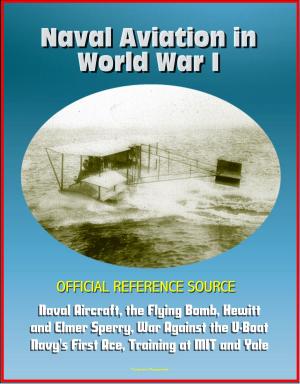A Preliminary to War: The 1st Aero Squadron and the Mexican Punitive Expedition of 1916 - Zapata, Desperado Pancho Villa, Curtiss JN-2, JN-4, Benjamin Foulois, John Pershing, Jeffery Trucks
Nonfiction, History, Americas, Mexico, Military, Aviation| Author: | Progressive Management | ISBN: | 9781311366375 |
| Publisher: | Progressive Management | Publication: | August 15, 2015 |
| Imprint: | Smashwords Edition | Language: | English |
| Author: | Progressive Management |
| ISBN: | 9781311366375 |
| Publisher: | Progressive Management |
| Publication: | August 15, 2015 |
| Imprint: | Smashwords Edition |
| Language: | English |
Professionally converted for accurate flowing-text e-book format reproduction, this Air Force publication is a history of the first deployment of the U.S. Army's entire air force, the 1st Aero Squadron, for an active campaign in Mexico.
On March 15, 1916, the 1st Aero Squadron arrived at Columbus, New Mexico, its train steaming into the crowded, chaotic town at 9:15 in the morning. Led by Capt. Benjamin D. Foulois, a lantern-jawed, bantam-weight former enlisted man, the squadron included eleven officers, eighty-two enlisted men, and one civilian technician. Under Foulois' direction, the men unloaded an automobile, six motorcycles, and twelve motor trucks, vehicles rare in 1916 New Mexico and even rarer in an army still wedded to the horse and mule. These were followed by wooden crates containing eight wood, wire, and fabric Curtiss JN-3 biplanes, every airplane owned by the U.S. Army, save those assigned to its aviation school at San Diego, California. The squadron was in Columbus to join an expedition commanded by Brig. Gen. John J. "Black Jack" Pershing. President Woodrow Wilson had ordered Pershing's force into Mexico in response to a March 9 attack on the tiny border town by the Mexican desperado, Francisco "Pancho" Villa. The event was auspicious. The course of the Punitive Expedition can be quickly summarized. Pershing's forces crossed into Mexico on March 15, 1916, and for the next month, several carefully coordinated cavalry columns pressed southward through the state of Chihuahua in an effort to locate Villa, while trying to avoid confrontations with troops loyal to the Mexican government, who were unhelpful at best and often downright unfriendly. Behind the cavalry, the expedition was supported along a lengthening line of communications extending from Columbus through bases at Colonia Dublan, Namiquipa, Bachiniva, San Antonio de los Arenales, and Satevo, the last over three hundred miles from the United States. The hard-riding cavalry ultimately reached Parral, another seventy miles south of Satevo, where a fight with Mexican government forces on April 15 marked the southern terminus of the American advance. Subsequently, at the limit of his logistic capability and concerned about threats to his extended line of communications, Pershing assumed a defensive posture. He organized the area controlled by the Punitive Expedition into districts, each patrolled by a cavalry regiment that harried guerrillas and kept an eye on government forces. Pershing maintained this position until the Punitive Expedition withdrew from Mexico early in 1917.
Professionally converted for accurate flowing-text e-book format reproduction, this Air Force publication is a history of the first deployment of the U.S. Army's entire air force, the 1st Aero Squadron, for an active campaign in Mexico.
On March 15, 1916, the 1st Aero Squadron arrived at Columbus, New Mexico, its train steaming into the crowded, chaotic town at 9:15 in the morning. Led by Capt. Benjamin D. Foulois, a lantern-jawed, bantam-weight former enlisted man, the squadron included eleven officers, eighty-two enlisted men, and one civilian technician. Under Foulois' direction, the men unloaded an automobile, six motorcycles, and twelve motor trucks, vehicles rare in 1916 New Mexico and even rarer in an army still wedded to the horse and mule. These were followed by wooden crates containing eight wood, wire, and fabric Curtiss JN-3 biplanes, every airplane owned by the U.S. Army, save those assigned to its aviation school at San Diego, California. The squadron was in Columbus to join an expedition commanded by Brig. Gen. John J. "Black Jack" Pershing. President Woodrow Wilson had ordered Pershing's force into Mexico in response to a March 9 attack on the tiny border town by the Mexican desperado, Francisco "Pancho" Villa. The event was auspicious. The course of the Punitive Expedition can be quickly summarized. Pershing's forces crossed into Mexico on March 15, 1916, and for the next month, several carefully coordinated cavalry columns pressed southward through the state of Chihuahua in an effort to locate Villa, while trying to avoid confrontations with troops loyal to the Mexican government, who were unhelpful at best and often downright unfriendly. Behind the cavalry, the expedition was supported along a lengthening line of communications extending from Columbus through bases at Colonia Dublan, Namiquipa, Bachiniva, San Antonio de los Arenales, and Satevo, the last over three hundred miles from the United States. The hard-riding cavalry ultimately reached Parral, another seventy miles south of Satevo, where a fight with Mexican government forces on April 15 marked the southern terminus of the American advance. Subsequently, at the limit of his logistic capability and concerned about threats to his extended line of communications, Pershing assumed a defensive posture. He organized the area controlled by the Punitive Expedition into districts, each patrolled by a cavalry regiment that harried guerrillas and kept an eye on government forces. Pershing maintained this position until the Punitive Expedition withdrew from Mexico early in 1917.















